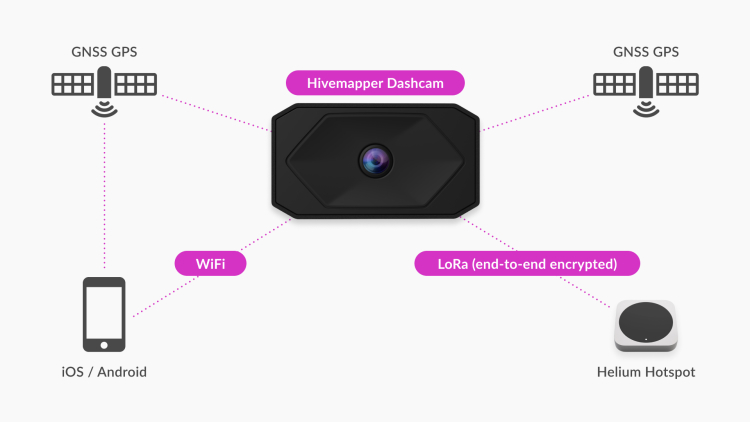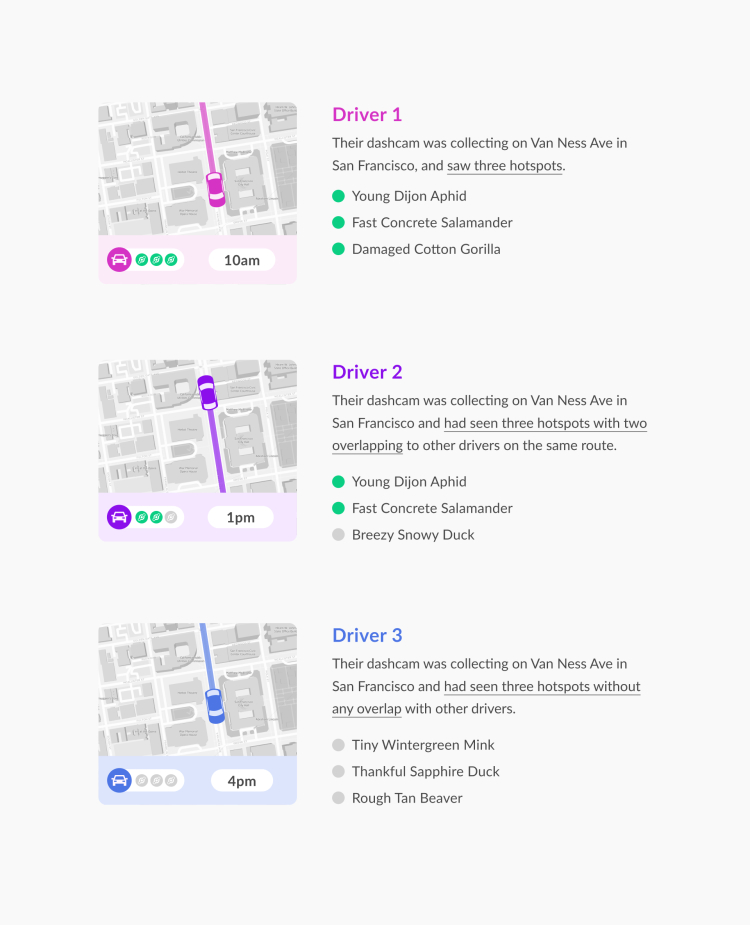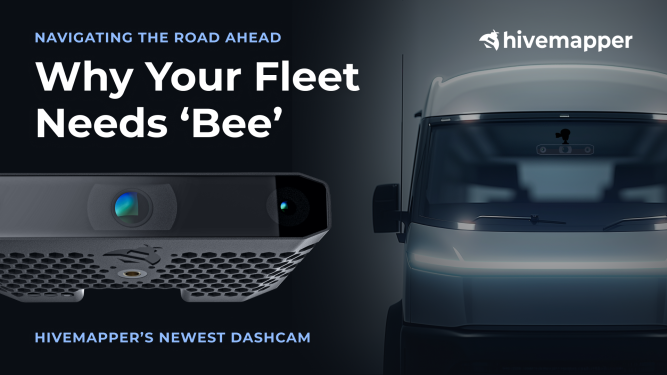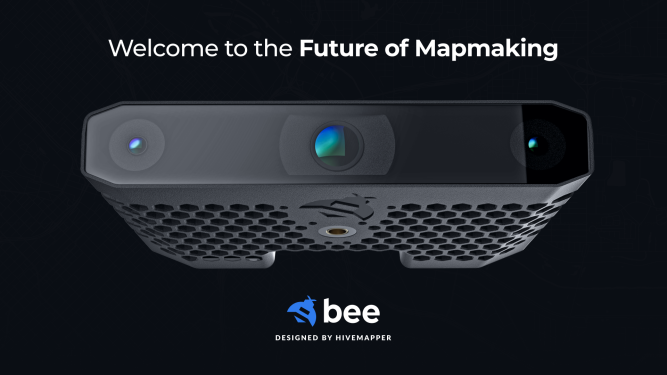The Latest Buzz
How Hivemapper uses Helium for location verification
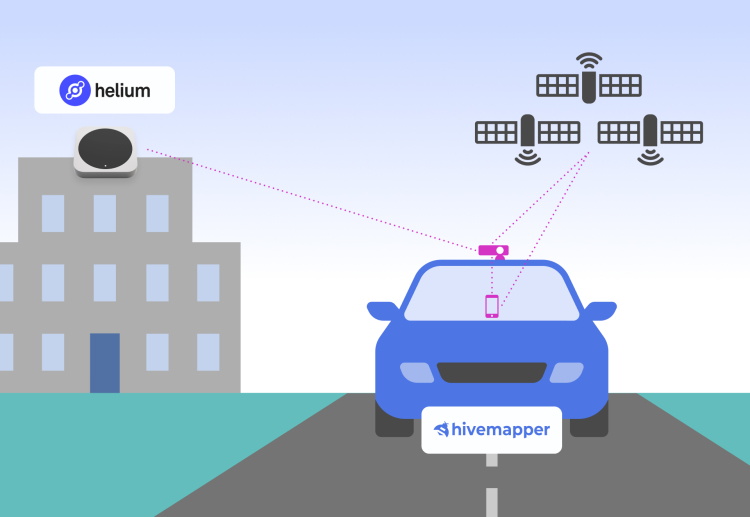
Why is location verification important?
As drivers collect 4K street-level imagery around the world, it’s critical that we trust the data they collect for the Hivemapper Network. Location data is central to our mapping efforts. Trusting location data requires that we have several independent sources of data to verify that the latitude and longitude coordinates uploaded to our network have not been falsified.
Why is Hivemapper using Helium to verify location?
Helium and Hivemapper share the same values around openness and privacy. Helium is a rapidly growing wireless network, used by Fortune 500 companies, and owned and operated by the people. Its coverage is in over 72,345 cities globally with over 938,000 hotspots deployed. Helium has all the advantages of open source and uses LoRaWAN to provide long-range low-power communication.
How does Hivemapper use Helium to verify location?
Helium enables Hivemapper to validate the location of a dashcam in two ways:
- The location of the Helium access point.
- The list of access points that the Hivemapper Dashcam sees as it travels down a route.
With Helium, we add another layer of validation to the mapping network. This extra layer of validation makes mapping with Hivemapper more fair because you don’t compete with cheaters, and customers can be confident in the veracity of the map imagery and data.
To better understand how localization works, let’s dig in. We think of each Helium hotspot at a given location as a digital fingerprint. When a Hivemapper Dashcam moves along a route, it reports which Helium hotspots it sees along its path. If two dashcams moving along the same path don't see some of the same Helium hotspots, there is potentially something nefarious about the dashcam's location.
Let’s consider an example illustrated in the graphic below. Driver #1's dashcam says it was collecting along Van Ness Avenue in San Francisco and saw three hotspots as shown below. A few hours later, driver #2's dashcam says it was collecting along Van Ness Avenue in San Francisco and also saw three hotspots, two of them overlapping with driver #1.
Finally, driver #3's dashcam says it was collecting with a Hivemapper Dashcam along Van Ness Avenue in San Francisco and saw three hotspots. However, none of the hotspots seen by driver #3 overlap with any of the other drivers collecting on Van Ness Avenue. This is cause for concern, and would automatically ensure that the collection from this dashcam is manually reviewed by Hivemapper Map QA before processing any of the data for the map.
What happens when we don’t have Helium coverage?
Hivemapper uses Helium as one of several sources to verify location. We rely on GNSS/GPS primarily for location data and can continue to function without Helium coverage in locations all over the globe.
Who pays the Helium Network access fees?
The Hivemapper Foundation pays for access to the Helium Network, not the dashcam owners. We have estimated the total costs and believe that they are very reasonable. Given the low cost nature of the Helium Network, we are excited to deploy Helium to address additional use cases beyond location verification. See more below.
How does the Hivemapper Dashcam function as a Helium mapper device?
The Helium coverage map is a crowdsourced and voluntary contribution project to provide a map of Helium coverage. When a Helium mapper observes a Helium hotspot, its location is added to the Helium coverage map. The Hivemapper Dashcam also functions as a Helium mapper device. Learn more here.
How does the Hivemapper Network ensure privacy?
Privacy is central to everything we do at Hivemapper. Here’s how we ensure that your location is kept private and not shared with the Helium Network:
- We use end-to-end encryption between Helium and the Hivemapper Dashcam over LoRaWAN.
- No location data is stored on-chain, and we never broadcast identifiable information over Helium.
- The Helium coverage map does not store individually identifiable information.
- During Helium coverage mapping, the location of the Hivemapper Dashcam is encoded to preserve the privacy of the Hivemapper Dashcam owner.
How does the Hivemapper Network prevent abuse?
Another important challenge is preventing any attempts to game the Hivemapper Network to nefariously mine HNT rewards. You can’t game the system because in order to earn Hivemapper Map credits you need to drive real roads. Also, it wouldn’t be cost-effective to install enough Helium hotspots to do this. This is by design. Hivemapper rewards contributors based on freshness, coverage, and other factors you can read more about here.
How does Hivemapper help Helium hotspot owners earn more rewards?
The more people use the Helium Network, the more Helium hotspot owners earn. The helium community earns HNT in a few ways. One way the Helium community is rewarded is with the “Network Data Transfer” reward type. Up to 37.50% of HNT per epoch is awarded to Network Data Transfer activity. When you map with the Hivemapper Dashcam, you increase Helium data usage and therefore help Helium hotspot owners earn more rewards. Learn more here.
Are there any additional uses for the Helium Network?
Today, location verification is the highest priority problem we are solving using the Helium Network. With the Hivemapper Dashcam now having the correct hardware to support the Helium Network we will look to use it to solve additional problems.
- Asset tracking. For example, if the Hivemapper App has not been able to connect to a Hivemapper Dashcam, the Helium Network can provide us with information on the health of the dashcam. Before releasing this capability we need to do in a privacy centric approach that maintains the privacy of the contributor.
- Our partner ecosystem is centered around the Open Dashcam (ODC) and its APIs. This means hardware partners will be able to use the Helium Network and the Open Dashcam APIs to solve enterprise level dashcam use cases around fleet management and beyond.
Share Post
